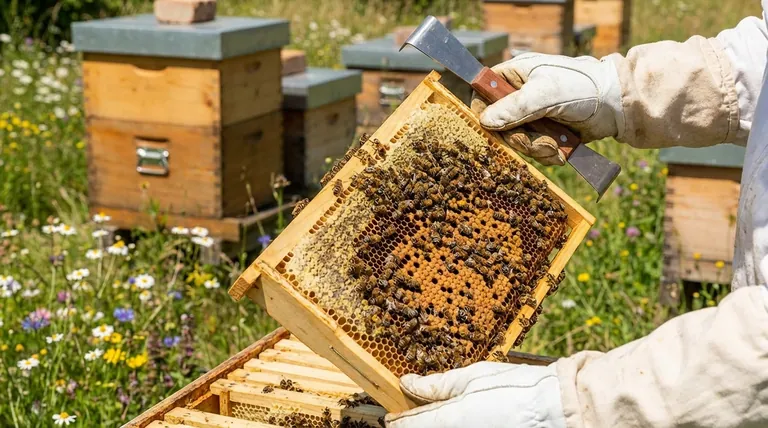In short, pollen trapping should only be considered when a honey bee colony is exceptionally strong, has a large population, and is clearly bringing in a surplus of pollen far beyond its own needs for raising brood.
The decision to trap pollen is not about maximizing a harvest; it is about responsibly managing a resource. Because pollen is the primary food source for developing bees, trapping it directly taxes the colony's ability to grow and thrive. It should only be done when the colony can easily afford that tax.

Why Pollen is a Colony's Most Critical Resource
To know when to take pollen, you must first understand its central role in the hive. Unlike nectar, which is the carbohydrate energy source for adult bees, pollen is the sole source of protein, fats, vitamins, and minerals.
The Protein for a New Generation
Pollen is the essential ingredient for raising new bees. Nurse bees consume pollen and convert it into "bee bread" and royal jelly, which they feed to larvae. A shortage of pollen directly translates to a smaller, weaker next generation of bees.
Fueling the Workforce
Without adequate pollen, a colony cannot replace its aging workforce. This leads to a dwindling population, reduced foraging capacity for both nectar and pollen, and an overall decline in hive health and productivity.
Assessing Your Colony's Strength for Trapping
Before installing a pollen trap, you must perform a rigorous and honest assessment of the colony. The term "strong" is not subjective; it has clear indicators.
What a "Strong" Colony Looks Like
A colony strong enough for trapping is typically booming. Look for a hive with two deep brood boxes that are packed with bees. It should contain at least six to eight frames with a solid, dense pattern of brood (eggs, larvae, and pupae). The adult bee population should be so high that they cover nearly every frame.
Identifying a True Pollen Surplus
Do not mistake high foraging activity for a surplus. You must confirm that the bees are storing more than they are using. Inspect the frames around the brood nest. You should see cells packed with multi-colored bee bread in abundance, indicating the colony has a pantry full of reserves.
The Importance of Timing
Trapping is only viable during a major pollen flow, typically in the spring and early summer when many different plants are blooming. Attempting to trap during a nectar-only flow or, even worse, a "dearth" (a period with few resources) can be devastating to the colony.
The Risks and Trade-offs of Pollen Trapping
Trapping pollen is an extractive process with inherent risks. It is your responsibility to understand and mitigate them.
Risk 1: Impeding Colony Growth
The primary risk is "protein starvation." By removing pollen, you are directly limiting the resources available for brood rearing. If you overtrap, the colony will shrink in population, which can weaken it against pests and diseases and drastically reduce any potential honey harvest.
Risk 2: Creating Nutritional Stress
A pollen trap does not just reduce the quantity of pollen but also its diversity. This can lead to nutritional deficiencies, making the colony more susceptible to diseases like chalkbrood and viruses.
Risk 3: Stressing the Hive
Forcing bees through a trap adds a physical obstacle to their daily work. It can slow foraging, damage the bees' wings or legs over time, and in some poorly designed traps, may even accidentally harm or dislodge the queen.
How to Implement Pollen Trapping Responsibly
If you have confirmed your colony is strong enough and a surplus exists, you can proceed with caution.
- If your primary focus is hive health and honey production: Do not trap pollen. Allow the bees to use all their resources to build a powerful workforce for the main nectar flow.
- If your primary focus is a small harvest for personal use: Trap intermittently. Engage the trap for one or two days, then disengage it for the next three or four to allow the colony to replenish its stores.
- If your primary focus is maximizing a pollen harvest: Dedicate exceptionally strong colonies to this task and monitor them relentlessly. You must be prepared to feed pollen supplements if you misjudge the flow or overtrap.
Ultimately, your role as a beekeeper is to be a steward of the hive's health, and any harvest is secondary to that core responsibility.
Summary Table:
| Assessment Criteria | Description |
|---|---|
| Colony Strength | 2 deep brood boxes, 6-8 frames of solid brood, large adult bee population. |
| Pollen Surplus | Abundant, multi-colored bee bread stored in cells around the brood nest. |
| Timing | During a major pollen flow (e.g., spring/early summer), never during a dearth. |
| Key Risks | Protein starvation, nutritional stress, and physical harm to foraging bees. |
Ensure your apiary has the right equipment for responsible management.
HONESTBEE supplies durable, high-quality beekeeping supplies and equipment to commercial apiaries and beekeeping equipment distributors through our wholesale-focused operations. From hive components to protective gear, we provide the tools you need to maintain strong, productive colonies.
Contact HONESTBEE today to discuss your wholesale needs and strengthen your beekeeping operation.
Visual Guide

Related Products
- Professional Dual-End Stainless Steel Hive Tool for Beekeeping
- HONESTBEE Professional Long Handled Hive Tool with Precision Cutting Blade
- Multi-Function Plier-Style Frame Grip Hive Tool
- HONESTBEE Professional Multi-Functional Hive Tool with Ergonomic Wood Handle
- Professional Stainless Steel Pry-Bar Hive Tool
People Also Ask
- What is a hive tool and what are its uses? Master Your Hive Inspections with the Essential Beekeeper's Tool
- How should beekeepers handle bees when using a hive tool? Master Calm, Deliberate Techniques
- What temperature is too cold to open a beehive? Protect Your Hive from Fatal Cold Shock
- Why is proper beekeeping equipment important? Essential for Safety and Hive Health
- What are the normal functions of a hive tool? The Essential Multi-Tool for Every Beekeeper



















